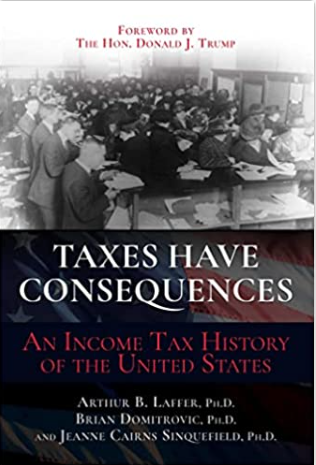
–>
November 20, 2022
For most of American history, the public agreed on a few fundamental premises —that people respond to incentives, that human flourishing and prosperity are desirable, and that prosperity cannot be fabricated from the top down. Today, these principles have been turned on their head. Consider some notable examples. In November 2022, President Joseph Biden argued that a windfall tax on gasoline would increase production and reduce prices. Barack Obama acknowledged that a capital gains tax increase might reduce government revenue and kill jobs, but went on to claim that it promoted “fairness.” Treasury Secretary Janet Yellen argued that supply side economics had failed; and that economic growth had to be created from the top down through “public infrastructure, R&D, and investments in a sustainable environment.”
‘); googletag.cmd.push(function () { googletag.display(‘div-gpt-ad-1609268089992-0’); }); }
 In Taxes Have Consequences, economist Arthur Laffer and his co-authors give a detailed history of taxation in the United States to offer a powerful defense of supply-side economics. This message is especially relevant at a time when stagflation has returned. We are again at a crossroad. Do we double down on failed policies of big government and easy money? Or do we harness the power of the free market to make everyone better off? Laffer argues that both short-term recovery and long-term growth depend on microeconomic incentives—particularly low tax rates, deregulation, and free trade.
In Taxes Have Consequences, economist Arthur Laffer and his co-authors give a detailed history of taxation in the United States to offer a powerful defense of supply-side economics. This message is especially relevant at a time when stagflation has returned. We are again at a crossroad. Do we double down on failed policies of big government and easy money? Or do we harness the power of the free market to make everyone better off? Laffer argues that both short-term recovery and long-term growth depend on microeconomic incentives—particularly low tax rates, deregulation, and free trade.
Laffer begins by explaining the relationship between taxation, government revenue, and economic growth. When tax rates are high, Laffer explains, top earners avoid astronomical payments by artfully utilizing loopholes in the tax code; and to access these loopholes, they hire more accountants and are forced to use their capital less productively. Laffer finds that, when marginal tax rates are 25 percent, “the top class of income earners logically spend 25 percent of their efforts on trying to reduce the tax impact on their earnings.” At a 75 percent tax rate, it’s 75 percent of their efforts. This means that changes in top marginal tax rates have a huge impact on economic output. For the Kennedy tax cuts, a 23 percent cut in the top marginal tax rate increased top earners’ after-tax return on making an extra dollar by 233 percent. For the 6 percent cut in the lowest marginal tax rate, the after-tax return increased by only 7.5 percent.
But understanding the relationship between taxation, government revenue, and economic growth is not enough to defend supply-side economics if equality is viewed as the highest economic priority. Thus, Laffer positions Taxes Have Consequences as an antidote to Thomas Piketty’s 2014 book, Capital in the 21st Century. Piketty argues that the top marginal tax rate must be drastically increased, to above 70 percent, to promote income equality. The book centers around a U-shaped curve, along which pretax reported income equality increases when the top marginal tax rate is lower and then decreases when the top marginal tax rate is higher. But, Laffer argues, the high tax rates of the past have hurt the lowest income earners far more than the rich. “Why would anyone want greater equality when everybody is worse off?”
‘); googletag.cmd.push(function () { googletag.display(‘div-gpt-ad-1609270365559-0’); }); }
Since the advent of the income tax in 1913, high tax rates have been associated with recession and economic stagnation. When the top marginal income tax was raised from 7 percent to 77 percent in 1918, reported income fell sharply, and recession followed for the next three years. When the top marginal tax rate dropped in the 1920s from 77 percent to 25 percent, the economy boomed, and the government ran a budget surplus for 11 straight years until the signing of the Smoot-Hawley Tariff in 1930. Exports fell by approximately the same amount as imports, while real wages fell. The Smoot-Hawley tariff was followed by tax increases from both Hoover and FDR, which reached an astonishing 79 percent in 1936. In classic fashion, these tax rate increases disincentivized production and intensified the Depression. Over the following three decades, low marginal top tax rates were correlated with periods of prosperity. For example, Kennedy’s tax cuts of the 1960s doubled the post-1953 growth rate average of 2.5 percent to over 5 percent.
Today, the economy teeters on the brink of recession. The current inflation rate has topped 8.5 percent and the debt-to-GDP ratio has reached 128 percent. Yet the Federal Reserve continues to dismiss fears of prolonged economic stagnation, while hoping that recession can be avoided by a series of 0.75 percent interest rate hikes. But many economists suggest that, when the overall amount of government debt is greater than the people expect the government to repay, inflation persists—as people attempt to quickly sell off their government debt before prices increase further. This means that the Fed’s monetarist view, in which controlling the money supply is the chief method of stabilizing the economy, cannot succeed by itself. Just raising interest rates will further increase debt payments, fueling a vicious cycle of worsening inflation.
Fortunately, Taxes Have Consequences offers us a way out. Today’s economic landscape is often compared to the stagflation of the 1970s. The reduction of inflation in the early 1980s is attributed primarily to Paul Volker’s hawkish monetary policy. But high interest rates alone cannot explain a shift toward higher rates of economic growth. The prosperity of the 1980s was also driven by deregulation and by large cuts in both individual income tax rates and corporate tax rates.
This provides a window into what policy should look like today. In order to combat inflation, interest rate hikes need to be accompanied with microeconomic incentives that drive real growth. Taxes Have Consequences shows that large tax increases aimed at increased government revenue and greater equity most often lead to less government revenue and stagnation—harming most those with lower incomes. Laffer’s careful analysis of the history of taxation over the past century shows that supply-side economics works. Low marginal tax rates help the poor and rich alike.
Anika Horowitz has interned for several public policy organizations and is a member of the DC-based Capitalist League.
<!– if(page_width_onload <= 479) { document.write("
“); googletag.cmd.push(function() { googletag.display(‘div-gpt-ad-1345489840937-4’); }); } –> If you experience technical problems, please write to [email protected]
FOLLOW US ON
<!–
–>
<!– _qoptions={ qacct:”p-9bKF-NgTuSFM6″ }; ![]() –> <!—-> <!– var addthis_share = { email_template: “new_template” } –>
–> <!—-> <!– var addthis_share = { email_template: “new_template” } –>





